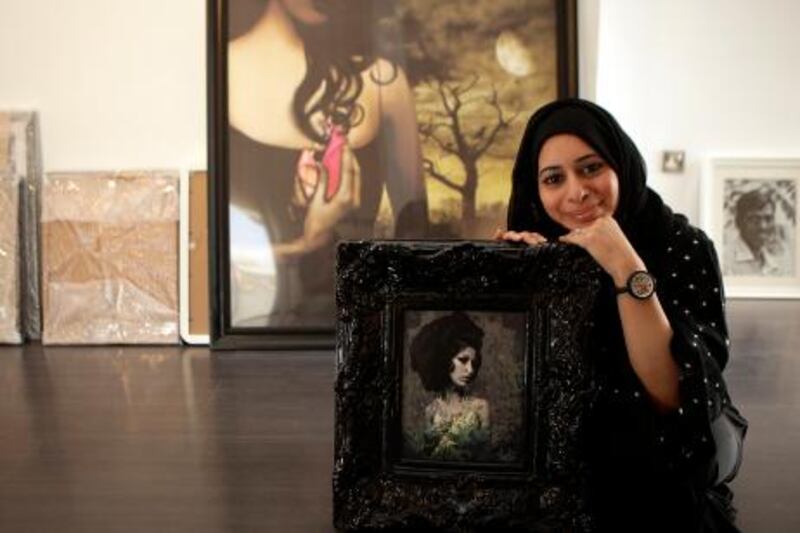How many times have you walked into a home and found one of the following images peering down from the walls: thin black lines that look a bit like bulrushes, an inconsequential splash of red and yellow paint (perhaps with the accompanying label, "Passion") or – a classic – five grey stones arranged in a soothingly disordered row?
Art: The National looks
Exhibitions, reviews, news, features and all things art
[ Art ]
This sort of shop-bought art (men sitting on a girder over New York city; a screen print of an antique colonial map; a confusing mass of colour, et cetera) is all well and good until you realise there are probably tens of thousands of other living rooms that huddle around the same visual centrepiece.
But art in the age of mass production comes with one upside: it's affordable. So with this in mind, and to temper the urge of many to rush out to the nearest furniture store and come back with a Basquiat-Mondrian hybrid nightmare, Sumayyah Al Suwaidi has organised the Ramadan Art Bazaar in Abu Dhabi's Ghaf Gallery for the past four years.
Encouraging both first-time buyers with a cap of Dh4,000 as the maximum asking price, and the assurance of originality of every work sold, Al Suwaidi selects a good mix of emerging and more established artists living in the UAE.
"It's definitely an eye-opener for people here that there is an affordable alternative to the duplicate artwork that sells in furniture stores," says Al Suwaidi, who is a digital artist herself who creates beguiling and sometimes rather chilling portraits that she twists on Photoshop and melds with her own hands-on painting practice.
Presenting the work in an informal, community-oriented environment is key. "A lot of people who come to the bazaar are not used to going to art galleries," she explains. "They feel that they don't know how to act around art or how to comment on it, and this can be intimidating. But this show and space feel very community-driven, as if visitors are going to someone's house rather than a formal art gallery."
Given that nights in the holy month can be a little quiet post-iftar, the Ramadan Art Bazaar has become firmly entrenched in the capital's calendar. While there are lots of different nationalities exhibiting, the bazaar is always a good place to see (and even get your hands on) work from some of the finest Emirati talent. While more established figures such as Mattar bin Lahej – who has exhibited internationally and was featured as part of the UAE at the Assilah programme in Morocco last year – and the Ghaf Gallery owner and painter Jalal Luqman are included, there's also a wealth of new names from across the Emirates.
The very promising Hamdan Al Shamsi, who creates wonderful images that weave together photography, painting and digital collage, is exhibiting and has fast become known for works that draw on the serenity of abundant Al Ain. Meanwhile, Zeinab Al Hashemi has been involved in a number of group shows, in Ductac and the Ara Gallery in Dubai, as well as a cultural exchange series at Abu Dhabi Art 2010. She often works in collage, with previous works including an attractive and tactile-looking collision of calligraphic headlines from newspapers synonymous with the founding of the UAE.
Though there are certainly artists working on more traditional subject matter – think camels, dhows, horses – their pieces are interspersed with work from those artists who dig a little further into the contemporary reality of the country. Al Suwaidi herself has a distinctive style. She says the solemn characters she creates with exaggerated, cavernous eyes came from her excavations of the internet in the mid-1990s. Always hungry for new imagery, the changes across the country since then have fed into her work.
Similarly, many of the international artists who are included often use their adopted life in the UAE as the centre of their work. Jennifer Simon, based in the Middle East for more than 10 years, often incorporates the cityscape of Abu Dhabi itself into her exuberant works, creating a frantic collision of western and local architecture.
Abu Dhabi might have few commercial art spaces at the moment, but Al Suwaidi suggests that what makes the Bazaar successful is understanding the capital's art crowd. She says there can be up to 150 visitors at any one time in Ghaf on opening night. The sense of ease and openness, she believes, is what draws them in.
The public wants to see more of this style of open-call art exhibitions in the UAE, she believes.
"This is also a good chance for other galleries to see this talent and invite them to take part in other exhibitions."
The Ramadan Art Bazaar opens today at 10am, then runs daily until August 31 from 9am-1pm and 9pm-11pm (closed Fridays). Call 02 665 5332 or visit ghafgallery.blogspot.com.





